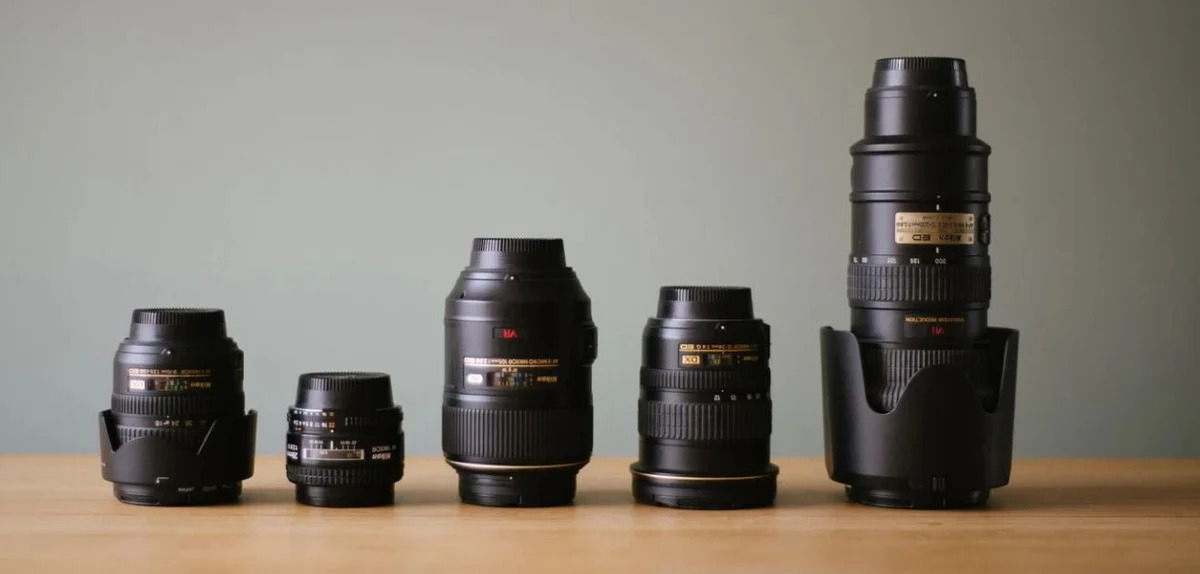
There are two basic categories of camera lenses:
1. Prime lenses. Primes have a fixed lens focal length, making them faster and sharper. While prime lenses are less flexible due to the fixed focal length, they are also fast and lightweight, making them easy to travel with
2. Zoom lenses. Zooms use a series of lenses to allow different focal lengths from a single lens, making them more flexible but not as fast. They contain more glass, which aids in their flexibility, but they also tend to be bigger and heavier than prime lenses.
Within both prime and zoom types of lenses, there are a variety of lenses, all with different focal lengths.
1. Macro Lenses
This type of camera lens is used to create very close-up, macro photographs. They have a unique design that allows them to produce sharp images at extremely close range. These lenses are great for nature photography, enabling you to capture an enormous amount of detail in one image.
2. Telephoto Lenses
Telephoto lenses are a type of zoom lens with multiple focal points. These types of lenses are great for isolating a subject that is far away. However, such great magnification comes at the price of a narrower field of view. In the same way that you would use a telescope to look at stars and planets, a telephoto lens is used for focusing in on distant objects. Many sports photographers use telephoto lenses to provide a sense of intimacy with the subjects on the field while standing on the sidelines or in the bleachers. There are many different types of telephoto lenses, and some can be quite large, heavy, and expensive, so take some time in choosing the right telephoto lens.
3. Wide Angle Lenses
Wide angle lenses are ideal for fitting a large area into your frame. This is especially useful for landscape photography or street photography. With wide angle lenses, almost everything is in focus, unless your subject is very close to the lens.
4. Standard Lenses
Standard lenses can be used for a variety of different types of photography. Their focal lengths fall somewhere in the middle, usually between 35mm and 85mm. A zoom lens within this range will have a small enough focal length at the bottom end to take a wider angle, full-frame photo, and a large enough focal length at the top end to zoom in on subjects.
5. Specialty Lenses
Finally, there are some more specialized camera lenses that can impart a unique look and feel to your photographs. There are several types of specialty camera lenses, but a few of the most prominent examples are:
Fisheye lens A fisheye lens is an ultra-wide-angle lens that can take in a full 180 degree radius around it. Fisheye lenses are so named because they distort an image’s field of view, making even a room in a house look like a bubble.
Tilt shift lens. A tilt shift lens distorts perspective, making things look smaller than they really are—almost as if they are toys.
Infrared lens These lenses play with light rather than perspective, filtering out all light waves except infrared for a unique visual effect.
Camera Lens Characteristics
All lenses filter and focus light so that it hits the sensor or film strip correctly. However, there are a variety of other factors that determine how a camera lens affects the look and quality of the final photo.
Focal length is the measurement of distance between the point of convergence of your lens and the sensor recording the image. The focal length range of a lens is expressed by a number, and that number tells you how much of the scene your camera will be able to capture. Smaller numbers have a wider angle of view and show more of the scene; larger numbers have a narrower angle of view and show less.
Aperture is how big the opening is that lets light in, expressed in f-stops. F-stops are counterintuitive, because the larger the number, the smaller the opening. For example, f/2.8 allows twice as much light into the camera as f4, and 16 times as much light as f11. Aperture affects the depth of field: larger openings create a shallower depth of field, while smaller openings make more of the image in focus.
Maximum Aperture Lenses will list a maximum aperture on the barrel, indicating the maximum width a lens aperture can open. Typically, lenses with a wider maximum aperture cost a bit more. A lens with a wide maximum aperture is great for low light situations, so if you are considering night photography, it might be worth the investment.
Depth of Field Controlling the amount of the photo that is in focus is one of the photographer’s best tools to help draw the viewer’s eye where you want it. For example, landscapes are typically shot so that everything is in focus, so photographers will shoot at small apertures. The depth of field varies with the type of lens, due to maximum aperture.

 Admin
Admin
Leave A Reply
Your email address will not be published. Required fields are marked *